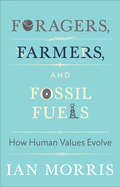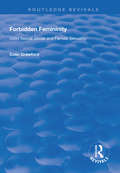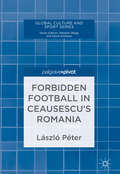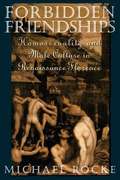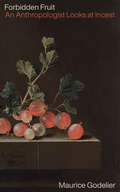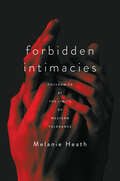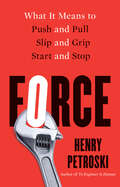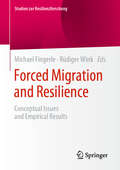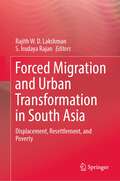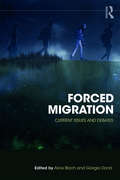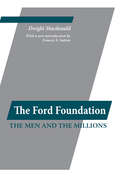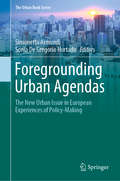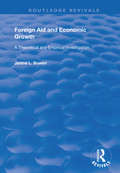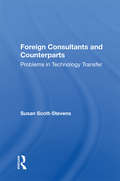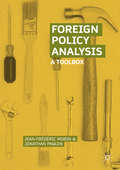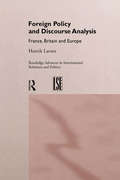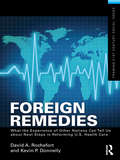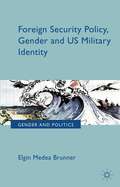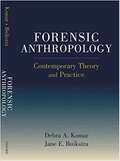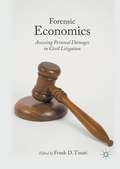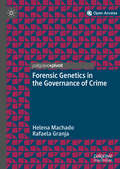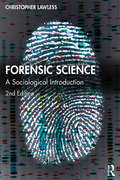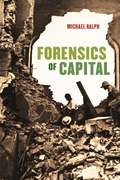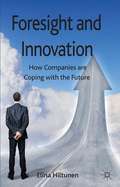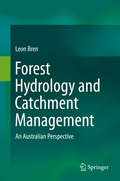- Table View
- List View
Foragers, Farmers, and Fossil Fuels: How Human Values Evolve
by Margaret Atwood Jonathan D. Spence Stephen Macedo Christine M. Korsgaard Ian Morris Richard SeafordMost people in the world today think democracy and gender equality are good, and that violence and wealth inequality are bad. But most people who lived during the 10,000 years before the nineteenth century thought just the opposite. Drawing on archaeology, anthropology, biology, and history, Ian Morris, author of the best-selling Why the West Rules--for Now, explains why. The result is a compelling new argument about the evolution of human values, one that has far-reaching implications for how we understand the past--and for what might happen next.Fundamental long-term changes in values, Morris argues, are driven by the most basic force of all: energy. Humans have found three main ways to get the energy they need--from foraging, farming, and fossil fuels. Each energy source sets strict limits on what kinds of societies can succeed, and each kind of society rewards specific values. In tiny forager bands, people who value equality but are ready to settle problems violently do better than those who aren't; in large farming societies, people who value hierarchy and are less willing to use violence do best; and in huge fossil-fuel societies, the pendulum has swung back toward equality but even further away from violence.But if our fossil-fuel world favors democratic, open societies, the ongoing revolution in energy capture means that our most cherished values are very likely to turn out--at some point fairly soon--not to be useful any more.Originating as the Tanner Lectures delivered at Princeton University, the book includes challenging responses by novelist Margaret Atwood, philosopher Christine Korsgaard, classicist Richard Seaford, and historian of China Jonathan Spence.
Forbidden Femininity: Child Sexual Abuse and Female Sexuality (Routledge Revivals)
by Colin CrawfordFirst Published in 1997, Crawford attempts to contextualise ideas of female sexuality as signified in academic, popular and in literary publications. Exploring themes of maternal sexuality, the suppression of female sexuality , clinical case studies and the reality of female sexuality in regards to Freudian and other literature.
Forbidden Football in Ceausescu’s Romania
by László PéterThis book presents an ethnographic description and sociological interpretation of the ‘football gatherings’ that evolved out of central Romania in the late twentieth century. In the 1980's, Romanian public television did not broadcast football mega-events for economic and political reasons. In response, masses of people would leave their homes and travel into the mountains to pick-up the TV broadcast from neighbouring countries. The phenomenon grew into a social institution with a penetrating force: it produced an alternative social space and a dissident public that pointed to a form of resistance taking place through football.Forbidden Football in Ceausescu’s Romania provides an insight into the everyday life under the pressure of dictatorship and, through the special patterns of sports consumption, it tells a social history through small individual stories related to football.
Forbidden Friendships: Homosexuality and Male Culture in Renaissance Florence
by Michael Rocke<p>The men of Renaissance Florence were so renowned for sodomy that "Florenzer" in German meant "sodomite." In the late fifteenth century, as many as one in two Florentine men had come to the attention of the authorities for sodomy by the time they were thirty. In 1432 The Office of the Night was created specifically to police sodomy in Florence. Indeed, nearly all Florentine males probably had some kind of same-sex experience as a part of their "normal" sexual life. <p>Seventy years of denunciations, interrogations, and sentencings left an extraordinarily detailed record, which author Michael Rocke has used in his vivid depiction of this vibrant sexual culture in a world where these same-sex acts were not the deviant transgressions of a small minority, but an integral part of a normal masculine identity. Rocke roots this sexual activity in the broader context of Renaissance Florence, with its social networks of families, juvenile gangs, neighbors, patronage, workshops, and confraternities, and its busy political life from the early years of the Republic through the period of Lorenzo de' Medici, Savonarola, and the beginning of Medici princely rule. His richly detailed book paints a fascinating picture of Renaissance Florence and calls into question our modern conceptions of gender and sexual identity.</p>
Forbidden Fruit: An Anthropologist Looks at Incest
by Maurice GodelierExploring the role of the incest prohibition in human societiesWhat is incest? Is it universally prohibited? Does this prohibition concern only "biological" kinships or does it extend to various "social" kinships, such as those that are formed today in so-called blended families but which also exist in many other societies?This prohibition plays a fundamental role in the functioning of the multiple kinship systems studied throughout the world. But where does it come from? Can we think, with Claude Lévi-Strauss, that the prohibition of incest alone marks the passage from nature to culture? And how can we understand, then, the persistent tension between the proclaimed, institutionalized prohibition and the incestuous practice which, everywhere, remains?World-renowned anthropologist Maurice Godelier highlights an essential fact, the spontaneously asocial and undifferentiated character of human sexuality and the need for a social regulation of this spontaneity. It thus brings to light the main teachings of anthropology on the question of incest, a major social fact of burning relevance today.
Forbidden Intimacies: Polygamies at the Limits of Western Tolerance (Globalization in Everyday Life)
by Melanie HeathA poignant account of everyday polygamy and what its regulation reveals about who is viewed as an "Other" In the past thirty years, polygamy has become a flashpoint of conflict as Western governments attempt to regulate certain cultural and religious practices that challenge seemingly central principles of family and justice. In Forbidden Intimacies, Melanie Heath comparatively investigates the regulation of polygamy in the United States, Canada, France, and Mayotte. Drawing on a wealth of ethnographic and archival sources, Heath uncovers the ways in which intimacies framed as "other" and "offensive" serve to define the very limits of Western tolerance. These regulation efforts, counterintuitively, allow the flourishing of polygamies on the ground. The case studies illustrate a continuum of justice, in which some groups, like white fundamentalist Mormons in the U.S., organize to fight against the prohibition of their families' existence, whereas African migrants in France face racialized discrimination in addition to rigid migration policies. The matrix of legal and social contexts, informed by gender, race, sexuality, and class, shapes the everyday experiences of these relationships. Heath uses the term "labyrinthine love" to conceptualize the complex ways individuals negotiate different kinds of relationships, ranging from romantic to coercive. What unites these families is the secrecy in which they must operate. As government intervention erodes their abilities to secure housing, welfare, work, and even protection from abuse, Heath exposes the huge variety of intimacies, and the power they hold to challenge heteronormative, Western ideals of love.
Force: What It Means to Push and Pull, Slip and Grip, Start and Stop
by Henry PetroskiAn eminent engineer and historian tackles one of the most elemental aspects of life: how we experience and utilize physical force &“Another gem from a master of technology writing.&”—Kirkus Reviews Force explores how humans interact with the material world in the course of their everyday activities. This book for the general reader also considers the significance of force in shaping societies and cultures. Celebrated author Henry Petroski delves into the ongoing physical interaction between people and things that enables them to stay put or causes them to move. He explores the range of daily human experience whereby we feel the sensations of push and pull, resistance and assistance. The book is also about metaphorical force, which manifests itself as pressure and relief, achievement and defeat. Petroski draws from a variety of disciplines to make the case that force—represented especially by our sense of touch—is a unifying principle that pervades our lives. In the wake of a prolonged global pandemic that increasingly cautioned us about contact with the physical world, Petroski offers a new perspective on the importance of the sensation and power of touch.
Forced Migration and Resilience: Conceptual Issues and Empirical Results (Studien zur Resilienzforschung)
by Rüdiger Wink Michael FingerleThis volume includes in a unique way theoretical and empirical contributions on the context of forced migration and resilience from the perspective of psychology and social sciences. Contributions range from analyses of individual vulnerability and exposition to investigations of community and policy reactions in host countries.
Forced Migration and Urban Transformation in South Asia: Displacement, Resettlement, and Poverty
by S. Irudaya Rajan Rajith W. D. LakshmanThis book discusses the displacement of urban populations, inequality, and poverty in three cities in South Asia—Colombo, Jaffna in Sri Lanka, and Kochi in India. It focuses on the long-term effect resettlement and relocation has on the lives and livelihoods of urban internal displacement of populations (IDPs) primarily from urban poor classes. It also discusses the concerns faced by the displacement in post-war Sri Lanka. It examines the impacts of conflict on poverty and recovery in peri-urban settings. It emphasizes the role of agency of urban IDPs in strengthening their own well-being. It draws attention to how the agency of urban IDPs is compromised by the displacement processes and the weak local level governance structures in the cities. The book is intended for researchers, graduate students, and teachers of Geography, Social Policy, Refugees and Migration Studies, History, International Development, Urban Studies, and South Asian Studies.
Forced Migration: Current Issues and Debates
by Alice Bloch Giorgia DonaForced Migration: Current Issues and Debates provides a critical engagement with and analysis of contemporary issues in the field using inter-disciplinary perspectives, through different geographical case studies and by employing varying methodologies. The combination of authors reviewing both the key research and scholarship and offering insights from their own research ensures a comprehensive and up-to-date analysis of the current issues in forced migration. The book is structured around three main current themes: the reconfiguration of borders including virtual borders, the expansion of prolonged exile, and changes in protection and access to rights. The first chapters in the collection provide both context and a theoretical overview by situating current debates and issues in their historical context including the evolution of field and the impact of the colonial and post-colonial world order on forced migration and forced displacement. These are followed by chapters framed around substantive issues including deportation and forced return; protracted displacements; securitising the Mediterranean and cross-border migration practices; refugees in global cities; forced migrants in the digital age; and second-generation identity and transnational practices. Forced Migration offers an original contribution to a growing field of study, connecting theoretical ideas and empirical research with policy, practice and the lived experiences of forced migrants. The volume provides a solid foundation, for students, academics and policy makers, of the main questions being asked in contemporary debates in forced migration.
Ford Foundation
by Dwight MacdonaldThirty years since it was first published, Macdonald's masterful book on the Ford Foundation remains the only book-length account of this institution that has been published. Despite the calls for a book carrying on the story from 1956 on the part of Richard Magat and McGeorge Bundy, that book has yet to be written. In his stimulating introduction to this new edition, Francis Sutton suggests why this is so. The Foundation, he observes, has never again aroused as much public interest as it did in the years Macdonald's describes. The announcement that a new program would be launched with the riches that 90 percent of the Ford Motor Company's stock would bring captured the attention of the media all across the country. Its sheer size was astounding; in 1954 the Ford Foundation spent four times as much as the Rockefeller Foundation and ten times as much as the Carnegie Corporation. Its expenditures were very large in relation to the budgets of the institutions that looked to it for help. Consequently, the American public waited expectantly to see what this huge foundation would do. But the Ford Foundation was not only big; it was controversial in those years, and inspired activism in the media, Congressional investigations, and political wrath. Macdonald nicely captures the American ambivalence toward large bureacratic organizations, which the Ford Foundation epitomizes, with its own language and, one might argue, its own values. Sutton points out that Macdonald's writing also sets a model for foundation history and indeed philanthropic history, with a poised, ironic detachment that has remained rare. His introduction points out the main themes of Macdonald's book and examines the extent to which they continue to illumine the foundation in the years since this book was first published. It looks at how well the Foundation has addressed the objectives it set for itself, and nicely captures the giant changes that this giant foundation has experienced through the 1960s and 1970s, to the present day.
Foregrounding Urban Agendas: The New Urban Issue in European Experiences of Policy-Making (The Urban Book Series)
by Simonetta Armondi Sonia De Gregorio HurtadoThis book highlights the discontinuities and the ongoing development of the urban question in policy-making in the context of the controversial current issues of global reversal and regional revival. It critically examines contemporary public policies and practices at the urban, regional and national scales in order to offer a timely contribution to the debate on the significance of the urban dimension and interpretation in terms of the theory, policy and practice of social-spatial research in the twenty-first century. Focusing on Europe, it explores the current urban policy agendas at different scales - and the mobility of those agendas -, their implications, contradictions and controversies. It brings together original contributions from multiple disciplines but with an urban perspective, including empirical case studies and critical discussions of the following topics:the UN 2030 Agenda for Sustainable Development, the global “New Urban Agenda” as part of the Habitat III process;the Urban Agenda for the European Union;national spatial policies related to urban agendas;urban agendas at regional/urban levels;city regionalism discourse and state rescaling;new formal regional and metropolitan governments as a solution (or problem);the role of new actors in regional urbanization dynamics; multi-level governance processes in developing an urban agenda; informal assemblages at the metropolitan scale aiming at constructing the urban concept and dimension.Given its scope, the book is of interest to urban, regional and EU policy-makers, scholars and students working in the fields of urban geography, urban studies, EU urban and regional policies, and planning.
Foreign Aid and Economic Growth: A Theoretical and Empirical Investigation (Routledge Revivals)
by Janine L. BowenPublished in 1998, this book provides an empirical analysis of the impact of foreign economic aid in 67 developed countries over a 19 year period. The results include the relationships between aid and growth and the implication that methodologies traditionally used have been largely responsible for inconsistent findings in the past.
Foreign Consultants And Counterparts: Problems In Technology Transfer
by Susan Scott-StevensEven though concern about and interest in technology transfer have existed since the 1950s, it has become of increasing importance to lesser-developed and developing countries since the 1970s. The transfer of technology in general, and in particular the transfer of technical knowledge, lies at the heart of the North-South debate. There is an abundance of literature on technology transfer in almost every field of interest--policy, practice, applied case studies, and general recommendations--but little, if any, of the information is integrated. It remains widely distributed throughout the fields of economics, business, rural sociology, and anthropology. The same may be said for various studies of consultants as change agents. On the other hand, studies of counterparts--host country professionals--have been almost entirely neglected, with the exception of their implied roles as innovators or acceptors. There have been few attempts to tie practice to theory, theory to research, or research to practice. This volume attempts to provide the link between theory, research, and practice. Based upon research conducted at two large-scale water resource development projects in Indonesia, it focuses upon the problems and solutions encountered by two primary sets of people involved in the transfer of technical knowledge--foreign consultants and host country counterparts. Dr. Scott-Stevens presents a unified and applied approach to many of the cross-cultural theories, issues, and problems common to the transfer of technical knowledge across cultures.
Foreign Policy Analysis: A Toolbox
by Jean-Frédéric Morin Jonathan PaquinThis book presents the evolution of the field of foreign policy analysis and explains the theories that have structured research in this area over the last 50 years. It provides the essentials of emerging theoretical trends, data and methodological pitfalls and major case-studies and is designed to be a key entry point for graduate students, upper-level undergraduates and scholars into the discipline. The volume features an eclectic panorama of different conceptual, theoretical and methodological approaches to foreign political analysis, focusing on different models of analysis such as two-level game analysis, bureaucratic politics, strategic culture, cybernetics, poliheuristic analysis, cognitive mapping, gender studies, groupthink and the systemic sources of foreign policy. The authors also clarify conceptual notions such as doctrines, ideologies and national interest, through the lenses of foreign policy analysis.
Foreign Policy and Discourse Analysis: France, Britain and Europe (Routledge Advances in International Relations and Global Politics)
by Henrik LarsenHenrik Larsen presents discourse analysis as an alternative approach to foreign policy analysis. Through an extensive empirical study of British and French policies towards Europe in the 1980s, he demonstrates the importance of political discourse in shaping foreign policy.The author discusses key theoretical problems within traditional belief system approaches and proposes an alternative one: political discourse analysis. The theory is illustrated through detailed analyses of British and French discourses on Europe, nation/state security and the nature of international relations.
Foreign Remedies: What the Experience of Other Nations Can Tell Us about Next Steps in Reforming U.S. Health Care (Framing 21st Century Social Issues)
by David A. Rochefort Kevin P DonnellyThe Patient Protection and Affordable Care Act marked a watershed in U.S. health policy, but controversy over its passage rages on, and much uncertainty surrounds the law’s transformation from blueprint into operational program. How can the experience of other nations help us to reconcile the competing goals of universal coverage, cost control, and high quality care? Following an analysis of the 2010 statute, this book surveys developments in different parts of the globe to identify important lessons in health politics, policy design, and program implementation. A concluding chapter examines the issue of resistance to foreign remedies within the process of U.S. health reform.
Foreign Security Policy, Gender, and US Military Identity
by Elgin Medea BrunnerThe concept of 'othering' which can be understood as the process of differentiation from the Self has been a basic tenet of the war story since war stories were first told. This practise of deliberate differentiation is indicative of the fact that war stories are essentially about the production of identity. The aim of this book, therefore, is to unravel some of the gendered ideologies that underpin the link between state identity and foreign security policy by looking at a certain case, state and foreign security policy. In particular this volume explores the identity of the United States through military documents on perception management in conflict from 1991-2007 shedding light on the 'othering' and the 'selfing' that occurs in these particular war stories. In doing so it lays bare the gendered ideologies that underpins US identity between these years as well as exploring potential spaces for alternatives. Thus, this book ventures a detailed and unique look at a particular aspect of the gendered reproduction of the state.
Forensic Anthropology: Contemporary Theory and Practice
by Debra Komar Jane BuikstraForensic anthropology is a vastly popular and rapidly changing profession, yet to date there has been no volume that reflects the current state of the discipline and forecasts its future. <p><p> The first comprehensive text in the field, Forensic Anthropology: Contemporary Theory and Practice examines the medical, legal, ethical, and humanitarian issues associated with forensic anthropology, current forensic methods, and bio-historical investigations. <p><p> Forensic Anthropology offers a unique synthesis of theoretical and methodological coverage. Rather than simply describing methodology, Komar and Buikstra place forensic anthropology in the broader context of medico-legal death investigations, critically evaluating practical techniques in a scientific framework and detailing the anthropologist's role in relation to both law enforcement and the medical examiner or coroner. <p><p> The authors review the current state of the field, emphasizing recent changes to the judicial guidelines regarding the admissibility of scientific evidence in court. They highlight the impact of these rulings, the increased need for scientific rigor, and the evolving nature of anthropological studies, preparing students to function effectively in the demanding judicial system that will evaluate their work in the future. The text also stresses the vital importance of research in the development of forensic applications of anthropology. <p><p> Forensic Anthropology is enhanced by numerous illustrative case studies and more than ninety photos and illustrations that help to deepen and enrich students' understanding of the material. Coauthored by a top authority in forensic anthropology and an anthropologist whose fieldwork has included medico-legal death investigation in Bosnia, Kosovo, Iraq, and Darfur, this volume is an in-depth and indispensable guide to the dynamic and rapidly professionalizing field of forensic anthropology.
Forensic Economics: Assessing Personal Damages in Civil Litigation
by Frank D. TinariThis edited collection addresses the major issues encountered in the calculation of economic damages to individuals in civil litigation. In federal and state courts in the United States, as well as in other nations, when one party sues another, the suing party is required not only to prove that the harm was, indeed, caused by the other party, but also to claim and demonstrate that a specified dollar value represents just compensation for the harm. Forensic economists are often called upon to evaluate, measure, and opine on the degree of economic loss that is alleged to have occurred. Aimed at both practitioners and theorists, the original articles and essays in the edited collection are written by nationally recognized and widely published forensic experts. Its strength is in showcasing theories, methods, and measurements as they differ in a variety of cases, and in its review of the forensic economics literature developed over the past thirty years. Readers will find informative discussions of topics such as establishing earnings capacity for both adults and infants, worklife probability, personal consumption deductions, taxation as treated in federal and state courts, valuing fringe benefits, discounting theory and practice, the effects of the Affordable Care Act, the valuation of personal services, wrongful discharge, hedonics, effective communication by the expert witness, and ethical issues. The volume also covers surveys of the views of practicing forensic economists, the connection between law and forensic economics, alternatives to litigation in the form of VCF-like schedules, and key differences among nations in measuring economic damages.
Forensic Genetics in the Governance of Crime
by Helena Machado Rafaela GranjaThis open access book uses a critical sociological perspective to explore contemporary ways of reformulating the governance of crime through genetics. Through the lens of scientific knowledge and genetic technology, Machado and Granja offer a unique perspective on current trends in crime governance. They explore the place and role of genetics in criminal justice systems, and show how classical and contemporary social theory can help address challenges posed by social processes and interactions generated by the uses, meanings, and expectations attributed to genetics in the governance of crime. Cutting-edge methods and research techniques are also integrated to address crucial aspects of this social reality. Finally, the authors examine new challenges emerging from recent paradigm shifts within forensic genetics, moving away from the construction of evidence as presented in court to the production of intelligence guiding criminal investigations.
Forensic Science: A Sociological Introduction
by Christopher LawlessForensic Science provides a comprehensive overview of the sociology of forensic science. Drawing on a wealth of international research and case studies, it explores the intersection of science, technology, law and society and examines the production of forensic knowledge. The book explores a range of key topics such as: • The integration of science into police work and criminal investigation • The relationship between law and science • Ethical and social issues raised by new forensic technology including DNA analysis • Media portrayals of forensic science • Forensic policy and the international agenda for forensic science This new edition has been fully updated, particularly with regard to new technology in relation to the various new forms of DNA technology and facial recognition. Updates and additions include: • Facial recognition technology • Digital forensics and its use in policing • Algorithms (such as probabilistic genotyping) • Genealogical searching • Phenotyping This new edition also reviews and critically appraises recent scholarship in the field, and new international case studies have been introduced, providing readers with an international comparative perspective. Engaging with sociological literature to make arguments about the ways in which forensic science is socially constituted and shapes justice, Forensic Science provides an excellent introduction to students about the location of forensic science and the ways it fits within the criminal justice system, as well as systems of professionalisation and ethics. It is important and compelling reading for students taking a range of courses, including criminal investigation, policing, forensic science, and the sociology of science and technology.
Forensics of Capital
by Michael RalphAs one of Africa’s few democracies, Senegal has long been thought of as a leader of moral, political, and economic development on the continent. We tend to assume that any such nation has achieved favorable international standing due to its own merits. In Forensics of Capital, Michael Ralph upends this kind of conventional thinking, showing how Senegal’s diplomatic standing was strategically forged in the colonial and postcolonial eras at key periods of its history and is today entirely contingent on the consensus of wealthy and influential nations and international lending agencies. Ralph examines Senegal’s crucial and pragmatic decisions related to its development and how they garnered international favor, decisions such as its opposition to Soviet involvement in African liberation--despite itself being a socialist state--or its support for the US-led war on terror--despite its population being predominately Muslim. He shows how such actions have given Senegal an inflated political and economic position and status as a highly credit-worthy nation even as its domestic economy has faltered. Exploring these and many other aspects of Senegal’s political economy and its interface with the international community, Ralph demonstrates that the international reputation of any nation--not just Senegal--is based on deep structural biases.
Foresight and Innovation
by Elina HiltunenForesight and Innovation is a guide for readers that are interested about the future. The book introduces a concept of futurist thinking, which includes anticipating, innovating and communicating about the futures. These concepts show how various organizations, all over the world are thinking, communicating and creating a better future.
Forest Hydrology and Catchment Management
by Leon BrenFor the last three centuries forests have been recognised as providing the best water catchments and valued for their sustained output of high quality water. In Australia, work which was commenced fifty years ago has come to fruition and is providing new information on forest hydrology issues. The book focusses on the issues of small streams, including catchment definition, slope, hydrograph formation, water quality measurement, and annual water yield. The world-wide management issues of sustaining riparian forests are examined, using the River Murray forests as an example. Finally a large amount of information is drawn together to examine the management of forested catchments for water supplies. This book presents an incisive, disciplined, quantitative approach to dealing with forest hydrology matters. Although world-wide in application, the book particularly draws on Australian studies. It is written with the needs of students and forest practitioners in mind.
